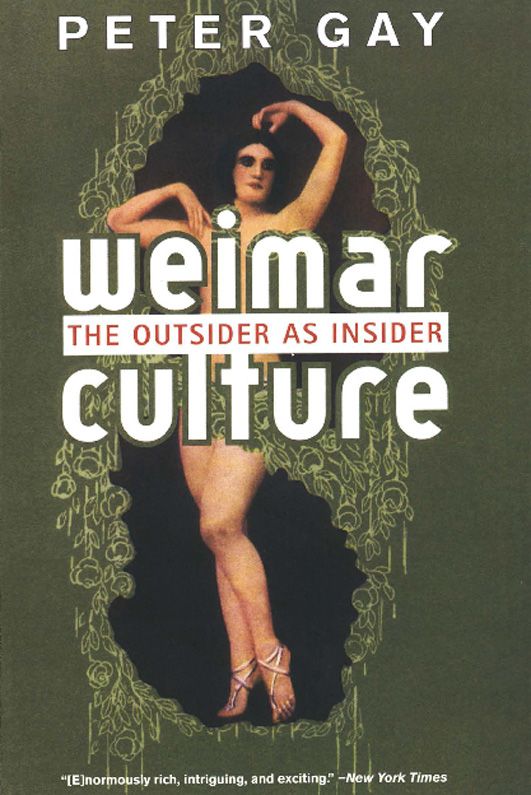Peter Gay: Weimar Culture: The Outsider As Insider (1968–) [EN, CR]
Filed under book | Tags: · 1910s, 1920s, 1930s, architecture, art, bauhaus, cinema, expressionism, film, germany, literature, modernism, music, nazism, philosophy, politics, psychoanalysis, theatre, weimar republic

First published in 1968, Weimar Culture is one of the masterworks of Peter Gay’s career. A study of German culture between the two wars, the book brilliantly traces the rise of the artistic, literary, and musical culture that bloomed ever so briefly in the 1920s amid the chaos of Germany’s tenuous post-World War I democracy, and crashed violently in the wake of Hitler’s rise to power. Despite the ephemeral nature of the Weimar democracy, the influence of its culture was profound and far-reaching, ushering in a modern sensibility in the arts that dominated Western culture for most of the twentieth century.
First published by Harper & Row, New York, 1968.
Publisher W. W. Norton, 2001
ISBN 0393322394, 9780393322392
205 pages
via chef
Review (Walter Laquer, The New York Times Books, 1968)
Review (Elizabeth Wiskemann, The Spectator, 1969)
Review (Sterling Fishman, History of Education Quarterly, 1970)
Weimar Culture: The Outsider As Insider (English, 1968/2001, EPUB)
Weimarksa kultura: Isključenik kao uključenik (Croatian, trans. Danja Šilović-Karić, 1999, added on 2014-8-3)
Katherine Hirt: When Machines Play Chopin: Musical Spirit and Automation in Nineteenth-Century German Literature (2010)
Filed under book | Tags: · 1800s, aesthetics, android, automation, history of literature, language, literature, machine, mechanics, music, music history, musical instruments, philosophy, phonograph

“When Machines Play Chopin brings together music aesthetics, performance practices, and the history of automated musical instruments in nineteenth-century German literature. Philosophers defined music as a direct expression of human emotion while soloists competed with one another to display machine-like technical perfection at their instruments. This book looks at this paradox between thinking about and practicing music to show what three literary works say about automation and the sublime in art.”
Publisher De Gruyter, 2010
Interdisciplinary German Cultural Studies series, 8
ISBN 3110232405, 9783110232400
170 pages
via alcibiades_socrates
Abstract of the thesis (2008)
Comment (0)Speculations V: Aesthetics in the 21st Century (2014)
Filed under journal | Tags: · aesthetics, art, avant-garde, literature, philosophy, speculative realism, theory

“Ever since the turn of the century aesthetics has steadily gained momentum as a central field of study across the disciplines. No longer sidelined, aesthetics has grown in confidence. While this recent development brings with it a return to the work of the canonical authors (most notably Baumgarten and Kant), some contemporary scholars reject the traditional focus on epistemology and theorize aesthetics in its ontological connotations. It is according to this shift that speculative realists have proclaimed aesthetics as “first philosophy” and as speculative in nature. With speculative realism aesthetics no longer necessarily implies human agents. This is in alignment with the general speculative realist framework for thinking all kinds of processes, entities, and objects as free from our allpervasive anthropocentrism which states, always, that everything is “for us.”
This special issue of Speculations: A Journal of Speculative Realism explores the ramifications of what could be termed the new speculative aesthetics. In doing so, it stages a three-fold encounter: between aesthetics and speculation, between speculative realism and its (possible) precursors, and between speculative realism and art and literature.”
With contributions by Steven Shaviro, Theodor Leiber and Kirsten Voigt Sellars, Matija Jelača, Claire Colebrook, N. Katherine Hayles, Jon Cogburn and Mark Allan Ohm, Miguel Penas López, Graham Harman, Bettina Funcke, Thomas Gokey, Robert Jackson, Roberto Simanowski, Francis Halsall, Magdalena Wisniowska Disegno, and Sjoerd van Tuinen.
Edited by Ridvan Askin, Paul J Ennis, Andreas Hägler, and Philip Schweighauser
Publisher punctum books, Brooklyn, NY, May 2014
Creative Commons License BY-NC-SA
ISBN 0692203168, 9780692203163
ISSN 2327-803X
474 pages
PDF (single PDF, 9 MB, updated on 2016-12-24)
PDFs (individual essays, updated on 2016-12-24)

